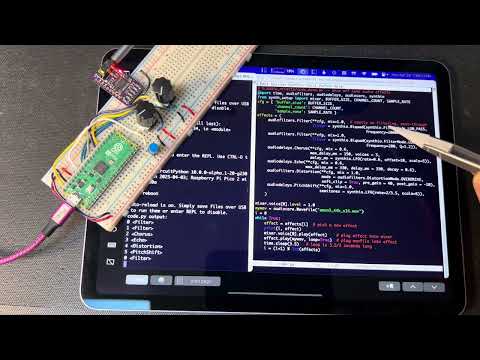The new audio effects libraries in CircuitPython are super fun. Here's a quick "taster" showing off some of them, part of my impending "Synthio Tutorial". Thanks Mark & Cooper for making them!
https://www.youtube.com/watch?v=nyv7XlQ1d00
#CircuitPython #synthio #audioeffects #synthdiy
#circuitpython
Coming Monday on a new episode of The CircuitPython Show: Meet Tim “foamyguy" Cocks. We chat about how he got started with computers, writing games for #CircuitPython, and more.
If any Boston-area #CircuitPython friends would like to come out to Boston College Arts Fest, Sat. April 26, my students are presenting 1-3pm both Physical Computing & #SwiftUI projects in the new MakerSpace building 245 Beacon St. Room 301. No pressure, but would love to see you there if interested & able! @blitzcitydiy @ecken @danhalbert. All welcome! https://www.bc.edu/content/bc-web/sites/bc-news/articles/2025/spring/arts-festival-2025.html
Catch up on the latest episode of The CircuitPython Show and learn about the new audio effects in #CircuitPython. Here's Mark Komus on why the rp2350 is the right microcontroller for audio effects:
Got 3 mins? Like #electronics #maker #art #circuitpython #raspberrypi & other cool stuff? Here's a brief 3 min video of students in my "no prior experience" Physical Computing course. First of three projects they'll create in a semester. Their build guides & code linked in desc. youtu.be/u-Jj8-GV404
A #circuitpython asteroid tracker, although honestly not even in my top 10 existential threats right now
New episode of @circuitpythonshow is out today! Learn all about the new audio effects in #CircuitPython with guests @todbot, @stylus, Mark Komus, and Cooper Dalrymple. Find the show wherever you get your podcasts or visit https://www.circuitpythonshow.com/@circuitpythonshow/episodes/audio-effects-panel-discussion
Coming Monday on The CircuitPython Show: Hear about the new audio effects in #CircuitPython and @todbot's quest for a fatter synth sound:
Coming Monday on the next episode of The CircuitPython Show: A panel discussion with @todbot, core developer @stylus, Mark Komus, and Cooper Dalrymple all about the new audio effects in #CircuitPython. Here's Cooper on what the effects are based on:
And just like that we have a functioning clock! currently running on a propmaker RP2040 but I will probably have to move over to something WiFi enabled before long #pcb #electronics #maker #RP2040 #RaspberryPi #jlcpcb #circuitpython @adafruit
Work in progress of a Reverb sound effect for CircuitPython. Based on FreeVerb. #CircuitPython #Reverb
And the winner of the most unexpectedly, well-named, software synth.... is...
@todbot for My Little Droney.
Classic. Well played :)
https://github.com/todbot/qtpy_synth/blob/main/circuitpython/dronesynth/my_little_droney.py
Anyone know if the Circuitpython Neopixel implementation uses PIO on the RP2040? The existence of neopixel_write in the HAL for CP implies it does...
But if so, what if you have an application that also wants to use PIO? How are conflicts managed?
#CircuitPython #Makers, I've heard Mu is being discontinued this year. I switched to PyCharm CE for my PhysicalComputing course last semester & it worked great, after the daunting (for newbies) setup & tio configuration. The code completion & error handling, plus adding CircUp, made things quite smooth. Is that still the recommended platform, or is there something else I should have on my radar? Thanks!
I'm glad I took the time to fix the scaly croissant's lizard enclosure sensors. I find the resulting nerdy plots quite interesting in several ways, especially the 3 temperature sensors.
The cool end sensor is an air temperature monitor in the rear left corner of the glass enclosure, and pretty much follows the ambient air temperature. Anything between about 21°C and 29°C is OK here for daytime, and down to 18°C or so is fine at night.
The warm end sensor also measures air temperature, but in the rear right corner of the enclosure, near the heat lamp. This is quite close to the air temperature sensor of the thermostat that controls the heat lamp, so the temperature measured here is fairly consistent and constant during the day. The actual temperature here doesn't matter very much, though
The basking temperature sensor in an infrared sensor measuring the surface temperature of Jerry's basking rock directly under the heat lamp. This is the temperature that's most important but it's also the one that varies the most, despite the use of a thermostat. The exact temperature isn't critical, but ideally it should be in the range 40-46°C.
The brief dips in basking rock temperature are a nice bonus of having this sort of sensor. They're an indication that a cool lizard has just plonked himself under the sensor to bask, so the frequency of dips in the data are an indirect indication of how active he's being.
The slower changes, on the other hand, are driven by changes in the ambient temperature in the room. When the room warms up the amount of heat escaping the enclosure decreases, the warm end air temperature starts to rise, so the thermostat turns down the heat lamp to compensate, and the basking spot temperature drops. It's important to have the thermostat's temperature sensor as close as practical to the basking spot in order to minimise this effect, but it's still pretty strong. Consequently, and counter intuitively, if I let the room get too hot them my lizard will end up with not enough heat rather than too much.
Ideally the thermostat controlling the heat lamp would use an infrared surface temperature sensor but all the commercially available ones just use an air temperature sensor. Maybe one day I'll make my own thermostat, with blackjack & direct surface temperature control.
Everything back in place and working as intended. There are air temperature and humidity sensors in the corner at both the warm and cool ends of the enclosure, an infrared temperature sensor aimed at the centre of the basking spot, and a UV sensor at the side of the basking area.
The ambient humidity is a bit high again today and the enclosure is following suit, but it's nice and cool which is helping to establish a good temperature gradient.
With the bad cables replaced this thing is once again reliable reading all the sensors, an sending the readings to both the e-ink display and an Adafruit IO web dashboard.
Before I can reinstall it all in the lizard enclosure I do need to reprint a couple of my 3D printed sensor mounts though, because they got broken.
I should probably update the software too, though it is all working as is.
Same cable problem with this analogue UV sensor, same hacky solution.
It's another bodge job, but this hacked up bit of Cat 5 will hopefully last a bit longer in the hot, high UV flux environment than the old lightweight ribbon cable.
This ribbon cable I used for the I2C infrared temperature sensor turned out not to be durable enough. It's in part of the enclosure illuminated with UV light, and I think that's why the insulation has crumbled off the wire. I'll need to replace this.

